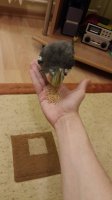Hello everyone. I'm Cal and recently I've got a parrot that I've named MooShu. He had some health problems but he's getting better and better by the day.
I want to target train him, so it would be easier for me to teach him to step up, following by letting him out of his cage more.
I'm new to target training. Today I've started some sessions. I'm using an skewers stick as the target, with the sharp end in my hand and the round end as the target. Also I couldn't find any clickers around, it's Christmas and most pet shops aren't even open so I can't ask if they are bringing some clickers in the near future. I'm using an app on the mobile phone that makes a sound. He sometimes bites the stick, or purely ignores it, or perching on it.
I'm trying to make him understand that when he hears the click, it's time for treats~!
So I'm clicking whenever he makes something that I like. For example, when he does a kind of chirp that I like, or if he perches on a stick that's more favorable for me when I give him the treats. But I don't really know if he got the idea that he gets something good to eat when he hears the sound or when he perches those sticks.
In the morning I've started with target training. But when he would grab the stick and I clicked, he would ran off by the time treats were close to the cage. After those "perch + click" sessions he now sits after the click and waits for that treat.
I've understood that I should click only when he touches the end of the skewers stick, not when he grabs it by the middle part, as it gets him confused if sometimes I reward the middle but not always, as I reward the end of the stick.
Any ideas that I should try? Or comment or give an like to this post if I'm doing great in this target training stuff.
Oh and, Happy Holidays to Y'all guys ^_^
You've all be so kind to me these days, I can't tell you how much I appreciate. Glad to be part of this community <3
I want to target train him, so it would be easier for me to teach him to step up, following by letting him out of his cage more.
I'm new to target training. Today I've started some sessions. I'm using an skewers stick as the target, with the sharp end in my hand and the round end as the target. Also I couldn't find any clickers around, it's Christmas and most pet shops aren't even open so I can't ask if they are bringing some clickers in the near future. I'm using an app on the mobile phone that makes a sound. He sometimes bites the stick, or purely ignores it, or perching on it.
I'm trying to make him understand that when he hears the click, it's time for treats~!

So I'm clicking whenever he makes something that I like. For example, when he does a kind of chirp that I like, or if he perches on a stick that's more favorable for me when I give him the treats. But I don't really know if he got the idea that he gets something good to eat when he hears the sound or when he perches those sticks.
In the morning I've started with target training. But when he would grab the stick and I clicked, he would ran off by the time treats were close to the cage. After those "perch + click" sessions he now sits after the click and waits for that treat.
I've understood that I should click only when he touches the end of the skewers stick, not when he grabs it by the middle part, as it gets him confused if sometimes I reward the middle but not always, as I reward the end of the stick.
Any ideas that I should try? Or comment or give an like to this post if I'm doing great in this target training stuff.
Oh and, Happy Holidays to Y'all guys ^_^
You've all be so kind to me these days, I can't tell you how much I appreciate. Glad to be part of this community <3


